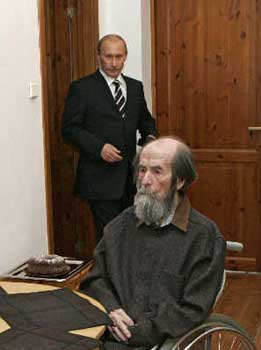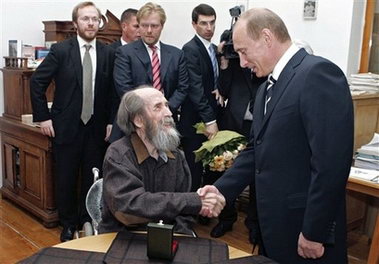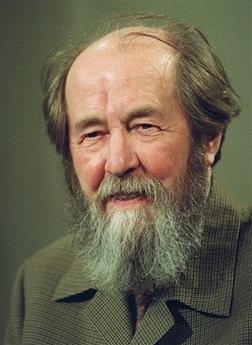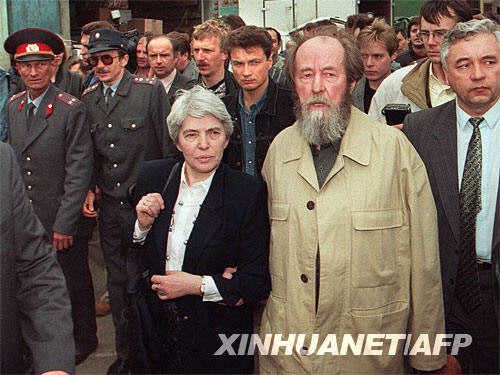Dear members of the Econometric Society,
On June 24, Leonid Hurwicz died at the age of 90. He was elected a Fellow of the Econometric Society in 1947 and served as the Society's president in 1969.Leo made seminal contributions to economics. In particular, he created the modern theory of mechanism design, the study of economic and political institutions for achieving society's goals. For this work he received the U.S. National Medal of Science in 1990 and shared the Nobel Memorial Prize in Economics in 2007, among many other honors. He was also an institution designer in the practical sense: he bears major responsibility for turning the Economics Department at the University of Minnesota into one of the great departments of the world. But it is Leo's personality that will be remembered most fondly by those who knew him. A warm and charming man, he had a deadpan sense of humor
that could turn somewhat sharp on occasion. Once a visiting seminar speaker wrote a theorem on the blackboard. Asserting that the result was "obvious," the speaker looked around the room, daring anyone to challenge him. Leo piped up immediately: "Is that proof by intimidation?"
Here is the link to the obituary that I wrote for the Guardian:
http://www.guardian.co.uk/business/2008/jul/21/economics.usa?gusrc=rss&fee=worldnews
Eric Maskin
2003 Econometric Society President
Obituary
Leonid Hurwicz
American economist and mathematician who was awarded the 2007 Nobel prize
- Eric S Maskin
- The Guardian,
- Monday July 21 2008
- Article history
Leonid "Leo" Hurwicz, who has died at the age of 90, was professor emeritus of economics at the University of Minnesota and the creator of mechanism design, the "reverse engineering" side of economics. Ordinarily, economists try to predict what outcomes are likely to arise from institutions such as markets, regulations, and taxes. But mechanism design theorists do the opposite: they begin with the desired outcome and ask whether an institution (ie, a mechanism) could be designed to achieve it.
To take a domestic illustration: Mother wishes to divide a cake between her two children, Alice and Bob, and to ensure that neither envies the other. Bob should not prefer Alice's piece to his own, nor vice versa. If Mother knows that the children see the cake the same way she does, she can simply divide the cake equally and give each child a piece. But if Bob might think his piece is smaller than Alice's then the simple solution will not work.
However, there is a procedure that will work: Mother can have Bob divide the cake and then let Alice choose which piece she wants, leaving the other for Bob. This mechanism achieves a fair division because it induces Bob to divide the cake so that the pieces are equal in his eyes. He will cut the cake so that whichever piece Alice selects, he is happy with the other. Alice will be happy too, since she gets to choose.
This illustrates some of the key features of mechanism design. The designer (Mother, in this case) does not have enough information in advance to identify which outcome will achieve her goal. Thus she must proceed indirectly through a mechanism, the divide-and-choose procedure, whose very execution, in effect, generates the information needed. To complicate matters, the participants (Alice and Bob) do not care about the designer's goals; their ends are to get as much cake as possible. Therefore, the mechanism must be consistent with their ends; it must be incentive-compatible.
Leo was the first to formulate all these concepts - mechanisms, their information-generating role, and incentive compatibility - in pioneering papers in 1960 and 1972. This was the work cited by the Nobel committee in awarding him the 2007 economics prize, together with Roger Myerson and myself.
Like many other economists, he had been fascinated by the "planning controversy" of the 1930s and 40s. Oskar Lange and Abba Lerner argued that centralised planning - properly conceived and carried out - could replicate and even surpass the performance of the competitive market, while Ludwig von Mises and Friedrich von Hayek remained staunchly sceptical of this claim. Leo recognised the importance of the debate, but found it unsatisfactory because all its principal terms remained undefined. It was his attempt to give unambiguous meanings to such concepts as "centralisation" and "decentralisation" that ultimately led him to mechanism design.
The line of work Leo inspired has led to a broad consensus among economists that Von Mises and Von Hayek were correct for settings in which there are large numbers of economic agents on both the buying and selling sides of the market - so that no single agent has much power - there are no significant "externalities" of consumption or production (so my consuming or producing a good does not directly affect you), and there are no serious asymmetries of information about the good (eg, sellers do not know more about it than buyers do). However, alternative mechanisms can, in general, be devised that improve on the pure market when any of the three conditions fails to hold.
Born in Moscow, to Polish-Jewish refugees, during the year of the Russian revolution, Leo returned with his family to Poland and graduated in law from Warsaw University in 1938. He then studied at the London School of Economics, with Von Hayek and Nicholas Kaldor, and with Von Mises at Geneva's Graduate Institute of International Studies.
In the US from 1940, he was at Harvard and the Massachusetts
Institute of Technology, where he became a research assistant to Paul Samuelson, and at the University of Chicago, where he was an assistant to Lange. After the US entered the second world war, Leo was a faculty member at Chicago's Institute of Meteorology, while lecturing in statistics in the economics department and on electronics to the US army's signal corps. In 1942 he began an association with the Cowles Commission for Research in Economics which lasted into the 1960s.
In 1951, after positions including professorships at Iowa State College and the University of Illinois, he joined Minnesota, where he remained for the rest of his career. But he travelled too, as visiting professor or fellow at universities including Stanford, Bangalore, Indonesia, Tokyo, Harvard, Berkeley, Santa Barbara, the California Institute of Technology and Michigan. He was the recipient, Nobel aside, of many awards, including the US National Medal of Science (1990) and six honorary doctorates.
The last two decades have seen a trend toward privatisation, the shift of public assets to the private sector. In eastern Europe, privatisation was induced by the fall of the Soviet Union and the imperative of transforming the old socialist states into market economies. In Britain and the US, the rationale was efficiency - where certain assets could be used more productively by private companies than by government. Privatisation requires mechanisms for transferring assets from one sector to the other. Thus, mechanism design has played an important role in some very practical issues.
I first learned about Leo's work from the great economist Kenneth Arrow, when I was a mathematics student at Harvard in the early 1970s. The experience persuaded me to switch from maths to economics. A few years later, Ken introduced me to Leo and we became friends and collaborators. He was a remarkably gentle, warm and gracious man with a devilish, deadpan sense of humour.
A few days ago I got a note from his daughter Sarah, who told me that at a 1993 summer school in Jerusalem, Leo was so beloved by graduate students that they followed him around like the pied piper. He was my pied piper too.
He married Evelyn Jensen in 1944. She survives him, as do their two daughters and two sons.
· Leonid Hurwicz, economist, born August 21 1917; died June 24 2008
http://news.sina.com.cn/w/2008-08-04/094816057269.shtml
89岁诺贝尔文学奖获得者索尔仁尼琴逝世
http://www.sina.com.cn 2008年08月04日09:48 中国新闻网
 资料图片:俄罗斯总统普京2007年6月12日前往莫斯科郊外索尔仁尼琴家中拜访这位时年88岁坐在轮椅上的伟大作家。
资料图片:俄罗斯总统普京2007年6月12日前往莫斯科郊外索尔仁尼琴家中拜访这位时年88岁坐在轮椅上的伟大作家。
 资料图片:普京拜访著名作家索尔仁尼琴。
资料图片:普京拜访著名作家索尔仁尼琴。
 资料图片:这张是1993年9月17日索尔仁尼琴在巴黎时拍摄的照片。
资料图片:这张是1993年9月17日索尔仁尼琴在巴黎时拍摄的照片。
 1994年5月28日在俄罗斯符拉迪沃斯托克拍摄的索尔仁尼琴(前右)和其妻子娜塔莎(前左)的资料照片。
1994年5月28日在俄罗斯符拉迪沃斯托克拍摄的索尔仁尼琴(前右)和其妻子娜塔莎(前左)的资料照片。




中新网布拉格8月4日电 1970年度诺贝尔文学奖获得者,被誉为“俄罗斯的良心”的世界著名作家索尔仁尼琴3日在他莫斯科的家中逝世,享年89岁。
据德新社援引俄塔社的消息报道,这位世界著名作家和历史学家已有数月之久没有在公开场合露面,未经证实的消息说他死于脑中风。
亚历山大.伊萨耶维奇.索尔仁尼琴1918年11月12日生于高加索基兹洛沃茨克一个教师家庭,1941年毕业于罗斯托夫大学数理系,曾服过兵役。因为在与朋友的通信中对斯大林有不敬之词,二战结束之后他在苏联监狱中度过8年,接着又被流放到哈萨克斯坦。1957年他恢复名誉,定居梁赞市担任数学老师。
索尔仁尼琴从上世纪60年代初开始走红苏联文坛。1962年他发表苏联文学中第一部描写斯大林时代劳改营的作品、中篇小说《伊凡.杰尼索维奇的一天》,引起轰动并受到赫鲁晓夫的赏识。
但是随着赫鲁晓夫下台,小说遭到公开批判。此后他所写的长篇小说《癌症病房》和《第一圈》都无法在苏联出版,只能在其它欧洲国家发表。1967年他在苏联第四次作家代表大会上散发公开信,抗议苏联的报刊检查制度,要求“取消对文艺创作的一切公开的和秘密的检查”。1969年他被苏联作协开除会籍。
1970年10月索尔仁尼琴因为“在追求俄罗斯文学不可缺少的传统时所具有的道德力量”而获诺贝尔文学奖。1974年因叛国罪被捕,并被驱逐出境。他先后旅居西德和瑞士,1976年迁往美国。1994年在当时的俄罗斯总统叶利钦邀请下索尔仁尼琴回到祖国。
索尔仁尼琴长达140万字的巨著《古拉格群岛》为他赢得了伟大思想家的荣誉。“古拉格”,即“劳动改造营管理总局”,作者将它比喻为“群岛”,意在指出苏联劳改制度已经渗透到政治生活的各个领域,变成苏联的“第二领土”。小说1973年在巴黎出版后轰动世界文坛,全球售出3000多万册。
“索尔仁尼琴是上一代作家中最后一位代表良知的作家”,俄罗斯女作家尤利兹娅认为,“他能够改变社会进程,或至少影响了国家和社会的发展”。80年代末的一次民意调查显示,48%的俄罗斯人希望他回国担任总统。
2007年俄罗斯国庆节那天,索尔仁尼琴获得2006年度俄罗斯人文领域最高成就奖俄罗斯国家奖。在获得诺贝尔文学奖37年之后,索尔仁尼琴终于在自己的祖国获得了肯定。
“全世界成百上千万人把亚历山大.索尔仁尼琴的名字和创作与俄罗斯本身的命运联系在一起。他的科学研究和杰出的文学著作,事实上是他全部的生命,都献给了祖国”,普京在颁奖典礼上说。
颁奖典礼结束后,普京还突然决定前往莫斯科郊外的索尔仁尼琴家中拜访由于健康原因无法去克里姆林宫领奖的作家。普京对他说:“我想特别感谢您为俄罗斯所做的贡献,直到今天您还在继续自己的活动。您对自己的观点从不动摇,并且终生遵循。”(黄频)
相关评论:索尔仁尼琴病逝 俄罗斯的良心永存
